利用芹菜废渣生产聚3-羟基丁酸酯的技术经济分析
IF 3.5
2区 农林科学
Q2 BIOTECHNOLOGY & APPLIED MICROBIOLOGY
引用次数: 0
摘要
从技术和经济两个方面对利用芹菜废渣生产聚3-羟基丁酸酯(PHB)的工艺进行了模拟和分析。该工艺从每年52,350吨芹菜废料中提取4397吨甘露醇,每年生产1871吨PHB。经济分析显示资本投资为1930万美元,强调设备费用占总费用的很大一部分。PHB生产过程的净现值为230万美元,投资回报率为15.7% %,投资回收期为6.4年,内部回报率为8.9% %。盈利能力分析表明,总收入为1030万美元,实际最低销售价格为5.5美元/公斤,最低可实现生产成本为4.6美元/公斤。敏感性分析强调了芹菜废料定价、固体负荷和萃取剂价格对PHB定价和经济可行性的影响。本文章由计算机程序翻译,如有差异,请以英文原文为准。
Techno-economic analysis of poly(3-hydroxybutyrate) production using Cobetia amphilecti from celery waste
A process for manufacturing poly(3-hydroxybutyrate) (PHB) using Cobetia amphilecti from celery waste was modeled and analyzed, focusing on the technical and economic aspects. The process produced 1871 tonnes/year of PHB from 4397 tonnes/year of mannitol extracted from 52,350 tonnes/year of celery waste. The economic analysis revealed a capital investment of 19.3 million US$, emphasizing equipment costs as a significant portion of the total expenses. The PHB production process has a positive net present value of 2.3 million US$, a 15.7 % return on investment, a payback period of 6.4 years, and an 8.9 % internal rate of return. Profitability analysis indicated a favorable scenario with a total revenue of 10.3 million US$, an actual minimum selling price of 5.5 US$/kg, and the lowest achievable production cost of 4.6 US$/kg. Sensitivity analysis underscored the influence of celery waste pricing, solid loading, and an extractant price for PHB pricing and economic viability.
求助全文
通过发布文献求助,成功后即可免费获取论文全文。
去求助
来源期刊

Food and Bioproducts Processing
工程技术-工程:化工
CiteScore
9.70
自引率
4.30%
发文量
115
审稿时长
24 days
期刊介绍:
Official Journal of the European Federation of Chemical Engineering:
Part C
FBP aims to be the principal international journal for publication of high quality, original papers in the branches of engineering and science dedicated to the safe processing of biological products. It is the only journal to exploit the synergy between biotechnology, bioprocessing and food engineering.
Papers showing how research results can be used in engineering design, and accounts of experimental or theoretical research work bringing new perspectives to established principles, highlighting unsolved problems or indicating directions for future research, are particularly welcome. Contributions that deal with new developments in equipment or processes and that can be given quantitative expression are encouraged. The journal is especially interested in papers that extend the boundaries of food and bioproducts processing.
The journal has a strong emphasis on the interface between engineering and food or bioproducts. Papers that are not likely to be published are those:
• Primarily concerned with food formulation
• That use experimental design techniques to obtain response surfaces but gain little insight from them
• That are empirical and ignore established mechanistic models, e.g., empirical drying curves
• That are primarily concerned about sensory evaluation and colour
• Concern the extraction, encapsulation and/or antioxidant activity of a specific biological material without providing insight that could be applied to a similar but different material,
• Containing only chemical analyses of biological materials.
 求助内容:
求助内容: 应助结果提醒方式:
应助结果提醒方式:


